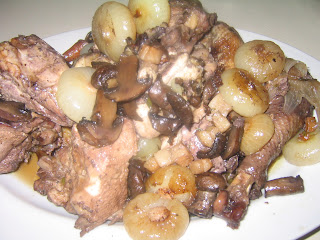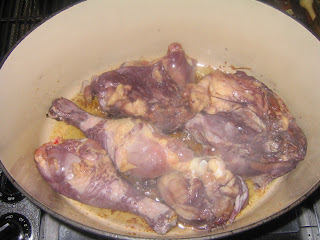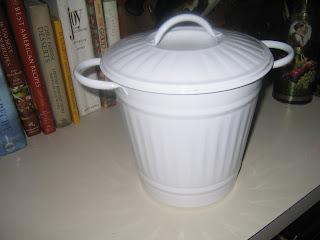
Some of you are probably convinced I spend half my days gazing into the meat display at Whole Foods. Well, you would be wrong. We don't have that much meat in our diet. In fact, there are so many scraps and leftovers from our catering work that we hardly do any grocery shopping at all for ourselves. We usually reserve meat for special occasions when friends come to dinner. But sometimes you just can't do without a little bit of meat in your cooking. Ham hocks, for instance, hark back to another era. In some dishes, such as old-fashioned split-pea soup, they are almost indispensable.
I recently noticed ham hocks at the Whole Foods. I don't know if that means they just started carrying ham hocks, or if I just never noticed before. But I shop there almost on a daily basis and suddenly there were these wonderful, gnarly looking ham hocks under the sausage and bacon display, along with packages of salt pork, which I also had not seen previously. Whole Foods carries Niman Ranch pork, a brand that is more like a cooperative of pork farmers, mostly in the Midwest, who have rejected the factory farming, feedlot methods of raising pigs and are trying to make a go of it by raising pigs outdoors and sometimes on pastures. Consumers are catching on. Niman Ranch farmers can't raise enough pigs to meet the demand. Their pork is fattier, more succulent, more flavorful than the pork you typically find in the average supermarket. So I was glad to see that Whole Foods was expanding its pork offerings to traditional items such as hocks and salt pork (its a smooth product that has actually been salted). Otherwise, I have to travel halfway across town to the butcher at Eastern Market, where they carry smoked jowl and smoked neck bones and bacon ends and pig's feet and pork brains and all sorts of other delightful stuff in addition to traditional hocks.
My parents used to make split pea soup with a big ham bone leftover from Sunday dinner. The bone still had plenty of meat, fat and gristle on it that always managed to work its way into the soup. The soup was thick, almost pudding-like, and not so easy for a kid to swallow, especially when a glob of fat turned up on your spoon looking you right in the eye. If you have such a ham bone, by all means use it in your soup. Otherwise, a couple of ham hocks (there are usually two to a package at the grocery) is an inexpensive way to infuse your soup with lots of flavor and not a terrible amount of fat.
This particular recipe couldn't be any easier. It's really just a slight modification of a split pea soup found in The Joy of Cooking. As a bonus, I am including farther down a recipe for a Southern souffleed corn bread advocated by Bill Neal in his book, Biscuits, Spoonbread, and Sweet Potato Pie. As a further bonus, I am including a recipe for an Indian-style split pea soup in case you are vegetarian but all of a sudden have an uncontrollable urge for split pea soup for some reason.
Split Pea soup
Serves 6-8 persons
2 cups green split peas
3 tablespoons extra-virgin olive oil
1 medium onion, diced small
2 medium carrots, diced small
2 stalks celery, diced small
1 teaspoon kosher salt
2 ham hocks
8 cups water
1 sprig thyme
1 bay leaf
1 teaspoon cumin
freshly ground pepper to taste
Soak the dried peas in a large bowl of water for five hours, or place in a pot of water, bring to a boil, then remove from heat and let steep for 1 hour. Drain and set aside.
In a heavy pot or Dutch oven, heat oil over high heat till it begins to smoke. Add onion, carrots and celery, season with salt and reduce heat to medium-low. Cook, stirring occasionally, until onions are soft, about 8 minutes. Add remaining ingredients, raise heat and wait till soup begins to boil, then turn heat to low and cook slowly for 3 hours, or until peas are perfectly soft.
Remove ham hocks, thyme and bay leaf. Set the hocks aside to cool. Meanwhile, run all but one cup of the soup through a blender in batches. (Remember to hold the lid down with a kitchen towel so you don't burn your hand.) The soup should be smooth, except for the bit of texture added by the last cup of unblended soup. When the hocks are cool enough to handle, take one of them and remove the fat. Find all the meat and break it in little pieces into the soup. Eat the other hock later with some good mustard, a slice of crusty bread and a bottle of beer. Or, feed it to the dog.
Souffleed Corn Bread
Makes 10 Wedges
Make this in your favorite 9-inch iron skillet. If you have an iron skillet reserved for corn bread, all the better. In his book Biscuits, Spoonbread, and Sweet Potato Pie, Bill Neal gives several recipes for corn bread ranging from the most basic Appalachian variety to the more refined "Company Corn Bread" reserved for special occasions. Neal was a celebrated revivalist of traditional Southern foods who spent quite a bit of time researching the origins of his preferred cuisine. His death from AIDS at age 41 was a loss to everyone who appreciates good regional American food. Corn bread is a classic pairing with split-pea soup, and requires hardly any effort at all.
Before you do anything, turn your oven on to 425 degrees, or you'll be standing there with your batter ready, waiting for the oven.
9-inch, well-seasoned iron skillet
1 1/2 cups white corn meal
1/2 cup all-purpose flour
2 tsp baking powder
1 tsp baking soda
1 tsp salt
2 eggs, separated
1 1/2 cups buttermilk
3/4 cup creamed corn
3 Tbs butter
In a large bowl mix together corn meal, flour, baking powder, baking soda and salt. Meanwhile, in a separate bowl or liquid measurer, mix the buttermilk, eggs and creamed corn. When the oven is ready, put the skillet in it to get hot. Melt butter in skillet, then stir into the buttermilk-egg-corn mixture. Return skillet to oven to get even hotter.
In a separate bowl, beat the egg whites to stiff peaks. Pour the wet ingredients into the dry ingredients and stir just until everything is incorporated. Fold in egg whites. Remove skillet from oven. Pour in batter. It might sizzle a little. That's a good sign. Return skillet to oven and cook about 30 minutes, or until cornbread is lightly browned and a tooth pick inserted into the middle comes out clean. Place skillet pan on a cooling rack. As soon as possible, remove corn bread from skillet and place on cooling rack. (I usually just invert the bread into a hot pad in one hand, then gently flip it over again onto the cooling rack.)
Indian-style Split Pea Soup
Serves 6-8 persons
Indian cooking is almost completely unexplored by most American cooks and that's a shame, as Indian cuisine (or cuisines, really) turns humble ingredients into fabulous flavors by making maximum use of aromatic spices. Once you have the ingredients, the cooking is not hard to follow. Try to track down an Indian grocery in your area. In India, split peas and other dried legumes are referred to as "dal." I am including this version of split pea soup because my wife says she likes it better than the traditional soup with ham.
1 pound split peas (green or yellow), soaked 5 hours in a large bowl of water, or broght to a boil in a pot of water, then set aside to steep for 1 hour.
3 tablespoons vegetable oil (or ghee, if you are familiar)
1 tablespoon grated fresh ginger
1 serrano chile, seeds and veins removed, then minced
1 1/2 teaspoons cumin seeds
1 teaspoon turmeric
7 cups water
1 stick cinnamon
8 whole cloves
4 black peppercorns
1/2 cup grated, unsweetened coconut
2 tart apples, peeled and grated
1 1/2 teasponns kosher salt
1/4 cup chopped cilantro leaves
In a heavy pot or Dutch oven, heat oil (or ghee) over moderately high heat. Add ginger, chili, cumin and termeric and cook, stirring frequently, until cumin seeds are lightly browned. Add water. Tie cinnamon, cloves and peppercorn in a piece of cheesecloth or place in a tea ball infuser and add to pot, along with peas, coconut, apple and salt. Bring to a boil. Reduce heat, cover and simmer gently until peas are very tender, about 3 hours.
Remove and discard cheesecloth containing spices (or simply remove tea ball infuser). Ladle half the soup into a blender and blend until smooth. Return soup to pot. Stir in chopped cilantro and serve.
 In her "Master Cook" column in the February 2007 issue of Food & Wine, Paula Wolfert calls this last step in a recipe for Provencal pork stew the "garnish." I have no idea why the editors decided to place this label on what essentially is the separate sauteeing of mushrooms, which are then added to the stew or daube and cooked again in the oven. Even in the French nomenclature, garniture does not seem an apt description for this process. Or maybe "garnish" is traditional to Provencale daube making. If so, it would have been nice to know.
In her "Master Cook" column in the February 2007 issue of Food & Wine, Paula Wolfert calls this last step in a recipe for Provencal pork stew the "garnish." I have no idea why the editors decided to place this label on what essentially is the separate sauteeing of mushrooms, which are then added to the stew or daube and cooked again in the oven. Even in the French nomenclature, garniture does not seem an apt description for this process. Or maybe "garnish" is traditional to Provencale daube making. If so, it would have been nice to know.



























